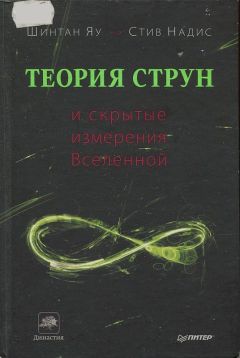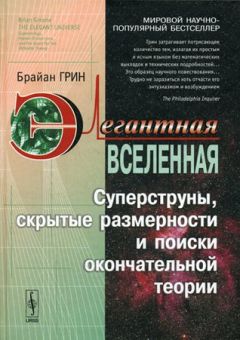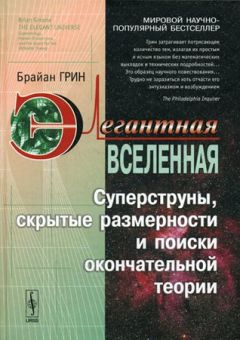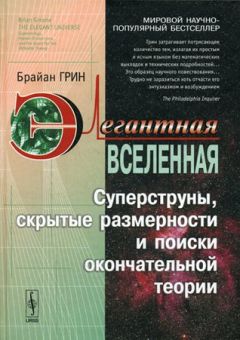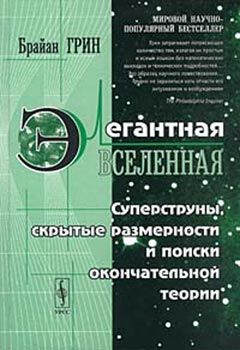Шинтан Яу - Теория струн и скрытые измерения Вселенной
Энергия вакуума — энергия, связанная с пустым пространством. Однако энергия, содержащаяся в вакууме, не равна нулю, поскольку в квантовой теории пространство никогда не является полностью пустым. Частицы непрерывно появляются на свет на мгновение и затем исчезают в небытие.
Энтропия — мера беспорядка физической системы; неупорядоченные системы имеют высокую энтропию, а упорядоченные — низкую. Энтропию также можно рассматривать как число способов перестановок, составляющих систему частей (например, молекул) без изменения общих характеристик системы, таких как объем, температура или давление.
Примечания
1
Plato, Timaeus, trans. Donald J. Zeyl (Indianapolis: Hackett, 2000), p. 12.
2
Так в книге. Правильно: «из двадцати треугольников» (прим. Vadi. Далее множество подобных «тупых» ошибок исправляю в тексте без примечаний)
3
Ibid., p. 46–47.
4
Ibid., p. 44.
5
Max Tegmark (MIT), interview with author, May 16, 2005. (Note: All interviews were conducted by Steve Nadis unless otherwise noted.)
6
Aristotle, On the Heavens, at Ancient Greek Online Library, http://greektexts.com/library/Aristotle/On_The_Heavens/eng/print/1043.html.
7
Michio Kaku. Hyperspace (New York: Anchor Books, 1995), p. 34.
8
H. G. Wells, The Time Machine (1898), available at http://www.bartleby.com/1000/1.html.
9
Abraham Pais, Subtle Is the Lord (New York: Oxford University Press, 1982), p. 152.
10
Oskar Klein, “From My Life of Physics,” in The Oskar Klein Memorial Lectures, ed. Gosta Ekspong (Singapore: World Scientific, 1991), p. 110.
11
Leonard Mlodinow, Euclid’s Window (New York: Simon & Schuster, 2002), p. 231.
12
Andrew Strominger, “Black Holes and the Fundamental Laws of Nature,” Lecture, Harvard University, Cambridge, MA, April 4, 2007.
13
Ibid.
14
Georg Friedrich Bernhard Riemann, “On the Hypotheses Which Lie at the Foundations of Geometry,” lecture, Gottingen Observatory, June 10, 1854.
15
E. T. Bell, Men of Mathematics (New York: Simon & Schuster, 1965), p. 21.
16
Leonard Mlodinow, Euclid's Window (New York: Simon & Schuster, 2002), p. xi.
17
Edna St. Vincent Millay, “Euclid Alone Has Looked on Beauty Bare,” quoted in Robert Osserman, Poetry of the Universe (New York: Anchor Books, 1995), p. 6.
18
Andre Nikolaevich Kolmogorov, Mathematics of the 19th Century (Birkhauser, 1998).
19
Deane Yang (Polytechnic Institute of New York University), e-mail letter to author, April 20, 2009.
20
Mlodinow, Euclid's Window, p. 205.
21
Brian Greene, The Elegant Universe (New York: Vintage Books, 2000), p. 231.
22
C. N. Yang. “Albert Einstein: Opportunity and Perception,” speech, 22nd International Conference on the History of Science, Beijing, China, 2005.
23
Chen Ning Yang, “Einstein’s Impact on Theoretical Physics in the 21st Century,” AAPPS Bulletin 15 (February 2005).
24
Greene, The Elegant Universe, p. 72.
25
Robert Greene (UCLA), interview with author, March 13, 2008.
26
Lizhen Ji and Kefeng Liu, “Shing-Tung Yau: A Manifold Man of Mathematics,” Proceedings of Geometric Analysis: Present and Future Conference, Harvard University, August 27-September 1, 2008.
27
Leon Simon (Stanford University), interview with author, February 6, 2008.
28
Greene, interview with author, March 13, 2008.
29
Cameron Gordon (University of Texas), interview with author, March 14, 2008.
30
Robert Geroch (University of Chicago), interview with author, February 28, 2008.
31
Edward Witten (Institute for Advanced Study), interview with author, March 31, 2008.
32
Edward Witten, “A New Proof of the Positive Energy Theorem,” Communications in Mathematical Physics 80 (1981): 381–402.
33
Roger Penrose, “Gravitational Collapse: The Role of General Relativity,” 1969, reprinted in Mathematical Intelligencer 30 (2008): 27–36.
34
Richard Schoen (Stanford University), interview with author, January 31, 2008.
35
Demetrios Christodoulou, The Formation of Black Holes in General Relativity (Zurich: European Mathematical Society, 2009).
36
John D. S. Jones, “Mysteries of Four Dimensions,” Nature 332 (April 7, 1998): 488–489.
37
Simon Donaldson (Imperial College), interview with author, April 3, 2008.
38
Faye Flam, “Getting Comfortable in Four Dimensions,” Science 266 (December 9, 1994): 1640.
39
Ibid.
40
Mathematical Institute at the University of Oxford, “Chart the Realm of the 4th Dimension,” http://www2.maths.ox.ac.uk/~dusautoy/2soft/4D.htm.
41
Grisha Perelman, “The Entropy Formula for the Ricci Flow and Its Geometric Applications,” November 11, 2002, http://arxiv.org/abs/math/0211159vl.
42
Eugenio Calabi (University of Pennsylvania), interview with author, October 18, 2007.
43
Robert Greene, interview with author, April 17, 2008.
44
Robert Greene, interview with author, June 24, 2008.
45
Eugenio Calabi, interview with author, October 18, 2007.
46
Robert Greene (UCLA), interview with author, January 29, 2008.
47
Eugenio Calabi (University of Pennsylvania), interview with author, May 14, 2008.
48
Ibid.
49
Erwin Lutwak (Polytechnic Institute of NYU), interview with author, May 15, 2008.
50
Calabi, interview, May 14, 2008.
51
Eugenio Calabi, interview with author, June 16, 2008.
52
Ibid.
53
Eugenio Calabi, interview with author, October 18, 2007.
54
Cumrun Vafa (Harvard University), interview with author, January 19,2007.
55
John Schwarz (California Institute of Technology), interview with author, August 13, 2008.
56
Michael Green (University of Cambridge), e-mail letter to author, August 15, 2008.
57
John Schwarz, interview with author, August 13, 2008.
58
Andrew Strominger (Harvard University), interview with author, February 7, 2007.
59
Andrew Strominger, interview with author, November 1, 2007.
60
Raman Sundrum (Johns Hopkins University), interview with author, January 25,2007.
61
Andrew Strominger, interview with author, February 7, 2007.
62
Dennis Overbye, “One Cosmic Question, Too Many Answers,” New York Times, September 2, 2003.
63
Juan Maldacena (Princeton University), interview with author, September 9, 2007.
64
Dan Freed (University of Texas), interview with author, June 24, 2008.
65
Tristan Hubsch (Howard University), interview with author, August 30, 2008.
66
Gary Horowitz (University of California, Santa Barbara), interview with author, February 15, 2007.
67
Eugenio Calabi (University of Pennsylvania), interview with author, October 18, 2007.
68
Woody Allen, “Strung Out,” New Yorker, July 28, 2003.
69
Liam McAllister (Cornell University), e-mail letter to author, April 24, 2009.
70
Allan Adams (MIT), interview with author, August 10, 2007.
71
Joe Polchinski (University of California, Santa Barbara), interview with author, January 29, 2007.
72
Brian Greene, The Fabric of the Cosmos (New York: Alfred A. Knopf, 2004), p. 372.
73
P. Candelas, G. Horowitz, A. Strominger, and E. Witten, “Vacuum Configurations for Superstrings,” Nuclear Physics В 258 (1985): 46–74.
74
Edward Witten (IAS), e-mail letter to author, July 24, 2008.
75
Volker Braun, Philip Candelas, and Rhys Davies, “A Three-Generation Calabi-Yau Manifold with Small Hodge Numbers,” October 28, 2009, http://arxiv.org/PS_cache/arxiv/pdf/0910/0910.5464vl.pdf.
76
Dennis Overbye, “One Cosmic Question, Too Many Answers,” New York Times, September 2, 2003.
77
Dale Glabach and Juan Maldacena, “Who’s Counting?” Astronomy, May 2006, p. 72.
78
Andrew Strominger, “String Theory, Black Holes, and the Fundamental Laws of Nature,” lecture, Harvard University, Cambridge, Mass., April 4, 2007.
79
Edward Witten (IAS), e-mail letter to author, July 21, 2008.
80
Petr Horava (University of California, Berkeley), interview with author, July 6, 2007.
81
Ibid.
82
Аллюзия на цитату из поэмы Томаса Стернза Элиота «Полые люди»: «Не взрыв, но всхлип». — Примеч. перев.
83
Ronen Plesser (Duke University), interview with author, September 3, 2008.
84
Ibid.
85
Marcus Grisaru (McGill University), interview with author, August 18, 2008.
86
